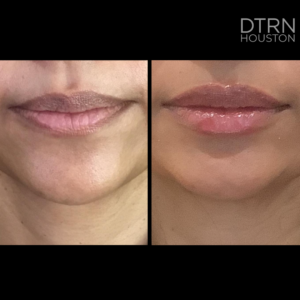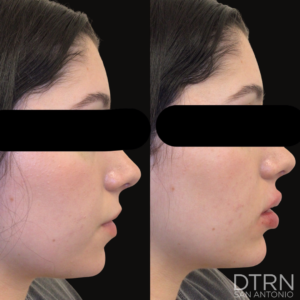As we age, our skin concerns shift and change. HA fillers are a popular treatment option commonly used to treat women and men in their 40s to address the signs of aging. In this post, we discuss some of the popular dermal fillers that work well for this age demographic, as well as common treatment areas, and how HA fillers work.
Age brings wisdom, as they say, though it also brings signs of aging that many men and women prefer not to deal with. Fortunately, with advancements in the cosmetics and aesthetics industry, there are several minimally invasive options to help individuals feel and look their best without going under the knife. One of those options is HA dermal fillers, like Juvederm.
Dermal fillers have become the second most popular minimally invasive cosmetic treatment, falling only behind neuromodulator treatments, like Botox, with HA fillers being the most commonly used filler type in the dermal filler arena.
As we move through the decades of adulthood, our faces continue to change, creating the need for different types of treatments over time to maintain a youthful appearance. In terms of dermal fillers, different fillers work well for different areas of concern, which change over time. For this post, we focus on the aesthetic concerns people begin to see in their 40s and the HA fillers that work best for those concerns.
So, what HA fillers are best for those in their 40s?
We turn to Houston, TX-based Nurse Injector Candace Bersani to find out the answer to this question and more!
What are the benefits of dermal fillers?
HA fillers offer a non-surgical option for women and men who want to turn back the hands of time. These injectable fillers for the face restore a more youthful appearance by plumping and filling out facial contours, making them one of the most effective treatments to restore fullness and a more youthful look to aging skin.
Dermal fillers offer several benefits to support an individual’s skin treatment goals, including to:
- Soften unwanted lines and creases
- Plump up your face and fill out contours
- Correct facial imbalance
- Improve the appearance of “sunken” eyes
- Improve recessed scarring
- Create luscious lips (lip augmentation)
- Contour the chin (chin augmentation)
- Contour the jawline (jaw contouring)
HA facial fillers provide a long-lasting, anti-aging option to restore the look of youth. In terms of some of the most popular HA filler treatment areas, Bersani shares that the lips, cheeks, and nasolabial folds are the most common treatment areas she treats, with more and more people starting to request a full face dermal filler treatment.

Lip Filler
How do HA fillers work?
Subcutaneous fat under the skin’s surface gradually decreases with age, as well as the volume of both the underlying muscle tone and bones themselves. Skin elasticity, age-related dryness, environmental factors, smoking, and diet also contribute to unwanted wrinkles and creases. In addition, about 40% of our skin is made of HA, which gradually decreases as we age – HA helps to hydrate and plump the skin.
HA fillers are injectable fillers made from hyaluronic acid created specifically to restore volume and fullness caused by these types of changes to the skin and skin concerns. They are injected directly into the treatment area for immediate volume and results. It takes about two full weeks for fillers to “settle” for the final results to be seen. Depending on the type of filler used and treatment area, HA fillers can last anywhere from six months to two years. Results of dermal filler treatments vary depending on the individual, the specific filler chosen, and the injection site.
When do we start seeing age-related volume loss?
Aging differs for each individual based on genetics, lifestyle, body chemistry, the environment, and more.
“Some patients will see age related volume changes as early as their late twenties or early thirties,” shares Bersani, “Some are fortunate enough to enter their forties without seeing much change at all. It largely depends on our genetics – thanks Mom and Dad!”
Bersani points out that volume changes in the face can also be largely affected by weight fluctuations – our faces tend to fill out when we gain weight and become thinner when we lose weight.
“On average, though, most patients will start to see the transition of fullness in the mid and upper face by the time they’re in their forties, making them take notice of more prominent nasolabial folds and heaviness in the lower face. Changes in the midface may also have an effect on the under eye area.”

Lower face filler
What are the best HA fillers for individuals in their 40s?
When it comes to the best fillers for men and women in their 40s, it can vary greatly on the individual and whether they’ve had dermal filler treatments in the past.
“In terms of the best fillers for those in their forties, it really depends on the amount of volume loss, area or areas of concern, and the patient’s own anatomy,” states Bersani, “In addition to this, whether or not the patient has been treated with filler previously can have an impact. There are many HA filler brands available on the U.S. market today. Here at DermaTouch RN, we mainly use the Juvederm family of HA fillers, which are very versatile.”
The Juvderm family of fillers includes dermal fillers for cheeks, lips, nasolabial folds, the jawline, the chin, and more. The specific fillers include:
- Ultra XC: For moderate to severe facial wrinkles and folds and lip augmentation, lasting up to 12 months
- Ultra Plus XC: For moderate to severe facial wrinkles, lasting up to 12 months
- Volbella: For adding volume to the lip area and treating vertical lip lines, lasting up to 12 months
- Voluma: For adding volume and definition to the cheeks and chin augmentation, lasting up to 24 months
- Volux: For moderate to severe loss of jawline definition, lasting up to 12 months
- Vollure: For severe wrinkles and lines of the lower face, lasting up to 18 months
Allergan, the makers of Juvederm, continue to expand the line and secure FDA-approval for other treatment areas for specific fillers.
Some of Bersani’s favorite Juvederm fillers to treat signs of aging are Voluma and Vollure.
“Voluma is a great filler for the lateral and anterior aspect of the midface. It’s also a favorite for the chin and prejowl sulcus. Voluma also has a new FDA approval coming for the temples, which is such a game changer to treat that area of the face,” Bersani continues, “I love Vollure to soften nasolabial folds and the labiomental crease. It’s just a lovely product for the moveable areas of the face. If I was going to be deserted on an island and had to choose one HA filler to bring with me, it would be Vollure!”
How do you determine the best approach to treatment?
Bersanie points out that “you really have to assess the face as a whole, including the jawline and lateral aspect of the cheek. This is true for any age, but especially for those in their forties, because it’s likely that it’s not just one area that is showing signs of change, especially if the patient has never addressed any of the current concerns previously.”
It’s helpful to have before and after photos when treating repeat patients.
“For me, if a patient has been with us [at DermaTouch RN] for years, I find it helpful to compare pictures from previous years where we can see some of the volume changes in a still frame. It helps them understand why they may need filler in an area different from that of their main concern, since filler in one area can have an effect on another area. Still photos are a good way to show cause and effect.”
How long does an HA filler treatment take?
An HA filler treatment lasts approximately 15 to 30 minutes, tailored to your specific needs and goals. Some appointments may take longer depending on the amount of filler being used and the areas being treated.
Comfortably reclined during the procedure, you’ll experience minimal discomfort. All Juvederm products contain lidocaine, and though sometimes minimal and temporary bruising or swelling may occur, an ice pack can be applied to help.
How much does a filler treatment cost?
The cost of HA dermal filler treatments varies based on factors such as the following:
- Type of filler used
- Amount of filler used
- Kind of treatment or number of treatment areas
- MedSap or Provider
- Location of the MedSpa or Provider
HA filler treatments using Juvederm, for example, can range from $300 to upwards of $3000, depending on such factors.
What other treatments complement HA filler treatments?
Treatments that work well in combination with HA dermal filler treatments include:
- Medical grade skin care at home
- Laser treatments, like BBL, CoolPeel, and Halo
- Sofwave
- Botox
- Microneedling
Schedule an HA filler treatment consultation
If you still have questions or are on the fence as to whether an HA filler treatment is right for you, contact your local MedSpa and ask to schedule a consultation. You can schedule with DermaTouch RN 24/7!
Candace Bersani, BSN, RN, CANS

Nurse Injector
Candace has been a registered nurse since 2019 after obtaining her Bachelor of Science in Nursing from the University of Texas Health Science Center in Houston. After graduation, she worked as an operating room nurse at one of the nation’s top hospitals, specializing in plastic and reconstructive surgery. This role not only allowed her to be the patient care advocate during surgery but also provided her with the unique experience of working alongside the surgeon, where she was able to observe facial anatomy up close.
Candace has always had a passion for aesthetics and skincare. She is committed to providing innovative aesthetic treatments to achieve a natural result centered around the patient’s aesthetic goals. Learn more about Candace and the team of professionals she works with.
DermaTouch RN offers minimally invasive and non-invasive treatments for men and women in Houston, San Antonio, Spring and Cypress, as well as the surrounding areas of Texas. We are the largest aesthetic practice in the Houston area, and all of our medical spa treatments are performed by a team of nurse practitioners, registered nurses, and aestheticians who receive continuing education to remain abreast of emerging treatments that benefit our patients. We invite you to learn more about our office before your consultation.





